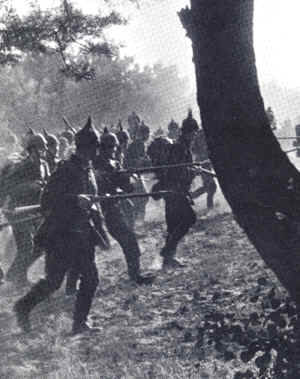The Battle of Mons was the first major battle of World War One. Mons was a battle of movement unlike the battles that followed which involved trench warfare.
 German troops advancing through Belgium |
German troops invaded Belgium on August 3rd. British troops from the BEF (British Expeditionary Force) had crossed to mainland Europe on August 14th. The BEF was led by Sir John French and by the time the BEF had got to Belgium they were behind with their schedule. French wanted a cautious approach until he and his force met up with the French Fifth Army led by General Lanrezac. The plan was for both forces to join up at Charleroi.
On August 22nd, the BEF came across cavalry patrols from the German First Army and engaged them. General French made plans to attack the German force that he assumed had to be in the region if they were sending out cavalry patrols. British intelligence warned him to be more cautious as the size of the German army in the vicinity was not known.
As a result of this intelligence, French ordered his men to dig defensive positions near the Mons Canal. The commander of the German First Army, Kluck, was surprised by the proximity of the British forces. He and his army had just engaged Lanrezac in battle (the Battle of Sambre) and was pursuing the French army south.
Kluck determined to take on the BEF and they first engaged the British in battle on August 23rd. French had deployed his men across a 40 kilometre front. The BEF was heavily outnumbered. The BEF had 70,000 men and 300 artillery guns whereas the German’s had 160,000 men and 600 artillery guns.
Despite such overwhelming numbers, the Germans did not do well at the start of the battle. The BEF may have been referred to as a bunch of “contemptibles” by the Kaiser William II, but they were professional soldiers. The Germans believed that they were facing many British machine guns at Mons. In fact, they were infantry men firing their Lee Enfield rifles but at such a combined speed that they gave the Germans that impression. German intelligence had estimated that the BEF had 28 machine guns per battalion at Mons – whereas each battalion only had two! After his experiences of the BEF at the Battle of Mons, Kluck, after the war had finished, described the BEF as an “incomparable army”.
| “Well entrenched and completely hidden, the enemy opened a murderous fire…the casualties increased….the rushes became shorter, and finally the whole advance stopped….with bloody losses, the attack gradually came to an end.” A German account of British troop fire at Mons |
The XII Brandenburg Grenadiers attacking the 1st Battalion of the Royal West Kent Regiment lost 25 officers and over 500 men. The 75th Bremen Regiment lost 5 officers and 376 men in just one attack, such was the ferocity of the BEF’s gunfire and their well dug defensive positions.
However, by evening French realised that the German army he faced was much bigger than his army. Also, unknown to him, the French army led by Lanrezac had retreated leaving the British army more exposed. French ordered his army to retreat. Kluck did not attack this retreat as he had to deal with the casualties in his army. However, on August 26th, a British rearguard guarding the retreat of the bulk of the BEF did sustain 8,000 casualties at the Battle of Le Chateau.
French wanted to withdraw his army to the coast but this was forbidden by Lord Kitchener who insisted that British stayed in contact with the French army as they retreated to the Marne River.
Related Posts
- The First Battle of the Marne The First Battle of the Marne was fought in September 1914. By September 12th, the end of the Battle…
- The Battle of the Somme started on July 1st 1916. It lasted until November 1916. For many people, the Battle of the Somme was the…